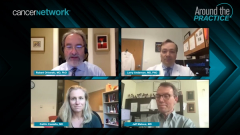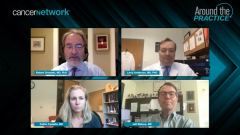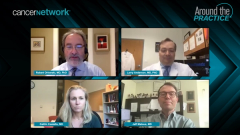
Goals of Therapy for Transplant-Ineligible MM
Kicking off a discussion regarding treatment approaches for transplant-ineligible multiple myeloma, a panel of hematologist-oncologists highlights goals of therapy for newly diagnosed patients.
Episodes in this series

Robert Orlowski, MD, PhD: Welcome to this CancerNetwork® Around the Practice presentation, “Management of Transplant-Ineligible Multiple Myeloma.” It’s my privilege to serve as your host. My name is Dr Bob Orlowski. I’m the director of the myeloma section in the department of lymphoma myeloma, which is part of the division of cancer medicine at [The University of Texas] MD Anderson Cancer Center in Houston, Texas. We’ve got a great group of panelists with us. Joining me today are Dr Larry Anderson, just a little north of me from The University of Texas Southwestern Harold C. Simmons Comprehensive Cancer Center in Dallas. Then [we have] Dr Jeff Matous from the Colorado Blood Cancer Institute in Denver [Colorado] and Dr Caitlin Costello from the University of California San Diego, who was making all of us envious by describing the wonderful weather that she has. Today we’re going to discuss challenges and the management of newly diagnosed multiple myeloma with a focus on transplant-ineligible patients. We’ll review 2 patient cases, involve our audience using an interactive online platform to answer poll questions, then have a discussion among the panelists and hopefully receive answers to some of your questions. Let’s go ahead and begin.
Here’s the first polling question, which is a warm-up: What is your specialty? Is it general medical oncology? Is it hematologic oncology? Is it hematology or is it other? Here’s the update. We’ve got some general medical oncology folks, some hematologic oncology, some hematology, and mostly others.
Let’s go to the next poll question. Approximately what percentage of your patients have a diagnosis of multiple myeloma? Your options are 10% or less, 11% to 20%, 21% to 30%, 31% to 40%, or 41% or more?
That’s a nice spread. We’ve got some people with less than 10% and some people with 41% or more, and a few folks in between. That’s a good distribution. Let’s go to the first part of our panel discussion, which is to review what the goals for treatment in patients with newly diagnosed myeloma and especially for transplant-ineligible folks. Larry, we can go alphabetically. You’ve got an A at the beginning of your name, so I’ll start with you.
Larry Anderson, MD, PhD: The ideal treatment response would be MRD [minimal residual response] negativity.
Robert Orlowski, MD, PhD: Jeff, what are your thoughts about treatment goals in this transplant-ineligible population?
Jeff Matous, MD: Getting the deepest response possible but avoiding toxicity is my goal. When I think about treatment response, I think complete response, however you want to define that. That’s a good goal in treating this population. In years past we didn’t have regimens that got us there often, but now we can be greedier, trying to get the best response possible. It’s always important, though, to balance that with toxicity concerns in this population.
Robert Orlowski, MD, PhD: Definitely. Caitlin, what about in your practice? What do you look for?
Caitlin Costello, MD: You’re right. I take into consideration many aspects of the patient—the patient’s health, the patient’s disease—and then practical things. Why is the patient transplant ineligible? Is it because of medical comorbidities? Is it because they don’t have a social support system? Is it because they’re old and frail? All those characteristics and concerns and questions help gauge what your treatment of approach will be. Of course, we want as deep of a response as possible but also need to make sure we’re considering what the patient’s goals of care are because I can continue to treat and make the numbers go lower and lower, but at what cost? We need to think about the patient and the disease as a whole when we’re making decisions and what our goals of treatment and response should be.
Robert Orlowski, MD, PhD: I agree with all your comments. If I could pull out 1 other suggestion for this transplant-ineligible group, it would be to try to reduce their disease-related symptoms. We of course want to get CR [complete response] and MRD in everybody, if we can. But in this older, more frail population, where they’re probably not going to be able to tolerate 4 drugs and may not even be able to stay on 3 drugs for an extended period, the more rapidly you make them feel better, the more likely it is that they’re going to be able to continue on treatment and then hopefully get to that MRD negativity.
Transcript edited for clarity.
Newsletter
Stay up to date on recent advances in the multidisciplinary approach to cancer.





















































































